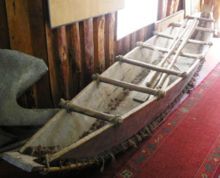- Maritime history of Chile
-
 View of Valparaíso Bay in 1830 before it became a mayor comercial hub in the South Pacific
View of Valparaíso Bay in 1830 before it became a mayor comercial hub in the South Pacific
The maritime history of Chile begins with the independence of Chile, but traces it origin in the colonial era and has ultimately origin in the sea faring tradition of the Iberian Peninsula, Europe and the Mediterranean as well as from indigenous peoples of Chile.
Contents
Pre-Hispanic times
Reconstruction of a dalca a type of pirogue that were used in Chiloé Archipelago, by both Spaniads and Huilliches who adopted it from the Chono people
The indigenous peoples that inhabited Chile at the time of the Spanish arrival had a wide range of different knowledges and relationships to seafaring. Some, like the Atacameños and Aymaras that had more complex cultures inhabited the inland of northern Chile and are likely to don't have navigated in the Pacific Ocean in at least, if they did, hundreds of years before the Spanish arrival. The Chango people inhabited the coast of northern Chile and used rafts made of skins from sea lions. They traded fish for agricultural products with the Aymara, Diaguitas and Atacameños.
In south-central Chile the Mapuche made extensive use of canoes mainly in rivers and lakes. In the far south of Chile, a land split by fjords and channels into islands and peninsulas, several peoples made extensive use of canoes for longer travels. These groups were the Chonos, Alacalufes (Kaweshqar) and Yamana (Yagán).
Conquest and colony
During the conquest of Chile maritime routes became crucial to supply the new colony as Chile was separated from Peru, its mother colony by the Atacama Desert. Numerous contingents of soldiers arrived to Chile by sea to fight the Arauco War. Since the colonization of Chile the country had its economy oriented towards cattle farming, mining and later on agriculture with the ports serving rather as access point to the relatively dense populated central valley than commercial hubs.
After the Archipelago of Chiloé was overrun by Huilliches from the north and conquered by the Spanish in the 1560s a unique maritime tradition emerged there blending Huilliche, Chono and Spanish influences. While mainland Chile occupied a rather small areas of what is now Chile, with its elongated shape, seafaring was not as important there for internal communications as it was in Chiloé.
During much of the colony Chile had a thriving shipbuilding industry, with the city of Valdivia producing the largest ships in the Kingdom of Chile. This industry flourished due to trade restrictions imposed by Spain, which forbid direct trade between Spain and Chile so that ships built in Spain rarely entered the South Pacific if it was not for exploration or military purposes. This changed after the Bourbon reforms during the second half of the 18th century when direct trade with Spain was allowed.
Independence and republic
 The Naval Battle of Iquique of 1879 shown in the picture is remembered a public holiday each May 21 in Chile, and authorities call may he month of the sea
The Naval Battle of Iquique of 1879 shown in the picture is remembered a public holiday each May 21 in Chile, and authorities call may he month of the sea
During the later stages of Chile's independence war it was conceived that the country needed a navy to bring under Chilean control areas that could not be reached by land like Chiloé Archipelago and Valdivia. The newly formed Chilean navy was put under command of Lord Cochrane, who introduced British customs. The Chilean navy succeeded in capturing Valdivia and landing a Chilean-Argentine army in Peru for further fight against the royalists.
Later on the Chilean navy saw action in the War of the Confederation, the Chincha Islands War, the War of the Pacific and the Chilean Civil War of 1891. The navy was also instrumental into bringing the Strait of Magellan and Easter Island under Chilean control in 1843 and 1888 respectively.
During the second half of the 19th century the Chilean navy begun a series of explorations towards the Patagonian archipelagoes. These explorations where fueled by several factors including the establishment of Chilean rule in the Strait of Magellan, the increased trade with Europe and border disputes with Argentina in Patagonia.
See also
Categories:
Wikimedia Foundation. 2010.

